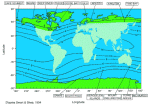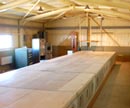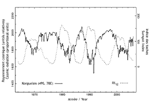
|

|

|
|
COSMIC RADIATION The French Institute for Research and the Polar Technology (IPEV) located in Brest organizes the polar scientific activity in the French Southern and Antarctic Lands (TAAF). Two monitors operated by the teams of IPEV in Kerguelen and Terre Adelie, permanently record the cosmic ray flux. The CERCLe team is given the responsability to retrieve and analyze the data and to place them at the disposal of the scientific community (see NMDB database). French stations & instruments  Several scientific bases exist in the French Southern Lands: Crozet Islands, Amsterdam and Kerguelen and in Antarctic: Dumont-d'Urville in Terre Adélie district and Concordia/Dome C, one of the three permanent bases located in the interior of the Antartic continent. The Port-aux-Français base in Kerguelen is located in the Indian Ocean at 50 degrees of Southern latitude and Dumont-d'Urville on the Antarctic coast at 66 degrees of Southern latitude. Several scientific bases exist in the French Southern Lands: Crozet Islands, Amsterdam and Kerguelen and in Antarctic: Dumont-d'Urville in Terre Adélie district and Concordia/Dome C, one of the three permanent bases located in the interior of the Antartic continent. The Port-aux-Français base in Kerguelen is located in the Indian Ocean at 50 degrees of Southern latitude and Dumont-d'Urville on the Antarctic coast at 66 degrees of Southern latitude.
 The specific interest of the cosmic ray observation at high latitudes is due to the easy penetration of the particles in these areas. The magnetic field of the Earth creates for each direction and each energy, complex trajectories (see figure). It "sorts" the particles arriving at a given geographical location. The specific interest of the cosmic ray observation at high latitudes is due to the easy penetration of the particles in these areas. The magnetic field of the Earth creates for each direction and each energy, complex trajectories (see figure). It "sorts" the particles arriving at a given geographical location.  Next figure shows which are minimal energies which can be observed in each point of the Earth and the locations of other observing stations. The figures indicated along the curves can be roughly read in GeV (the giga electronvolt corresponding to a billion electronvolt) Next figure shows which are minimal energies which can be observed in each point of the Earth and the locations of other observing stations. The figures indicated along the curves can be roughly read in GeV (the giga electronvolt corresponding to a billion electronvolt)
 To observe the cosmic
radiation with these energies on the ground, one uses "Neutrons
monitors" (the figure shows the neutron monitors at Kerguelen station): the secondary particles created in the Earth's atmosphere by the protons of the cosmic radiation (principal component of this radiation) create themselves many neutrons in the apparatus: they're slowed down so we can count them thanks to a "proportional counter". To observe the cosmic
radiation with these energies on the ground, one uses "Neutrons
monitors" (the figure shows the neutron monitors at Kerguelen station): the secondary particles created in the Earth's atmosphere by the protons of the cosmic radiation (principal component of this radiation) create themselves many neutrons in the apparatus: they're slowed down so we can count them thanks to a "proportional counter".
Interest in observing cosmic rays The cosmic rays of very high energy (energies higher than 1019 eV) are not deviated by the galactic magnetic field or by that in which bathes the solar system or that of the Earth. They thus store the information on their original direction, but they are very rare (a particle per square kilometre and century instead of a particle per square centimetre and per second for the particles of "low" energy).  On the
contrary, for the energies measured by "neutrons monitors", the
radiation would be isotropic if the magnetic field of the
interplanetary medium did not deviate the particles. The observations
of the cosmic rays are thus used to study and supervise the
interplanetary medium. Their propagation for example is disturbed by
the shock waves produced by the Sun flares and by many other effects. Thus during the eleven years solar cycle, there is a clear variation of the cosmic radiation. The protons accelerated during solar flares are added to those of the cosmic radiation of galactic origin and if very energetic, they are detected on the ground. They are the subject of scientific studies but also of monitoring because they can for example increase the amount of radiation received onboard aircrafts. On the
contrary, for the energies measured by "neutrons monitors", the
radiation would be isotropic if the magnetic field of the
interplanetary medium did not deviate the particles. The observations
of the cosmic rays are thus used to study and supervise the
interplanetary medium. Their propagation for example is disturbed by
the shock waves produced by the Sun flares and by many other effects. Thus during the eleven years solar cycle, there is a clear variation of the cosmic radiation. The protons accelerated during solar flares are added to those of the cosmic radiation of galactic origin and if very energetic, they are detected on the ground. They are the subject of scientific studies but also of monitoring because they can for example increase the amount of radiation received onboard aircrafts.
| ||